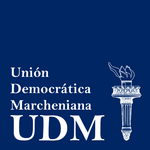User:Mu/Sandbox3
Jump to navigation
Jump to search
This article lists political parties in Marchenia.
Parties with federal representation
| Party logo | Party name | Leader | Senate seats | National Assembly seats | Seats in state governments |
Local government seats |
Ideology | |
|---|---|---|---|---|---|---|---|---|

|
Marchenian Democratic Union Unión Democrática Marcheniana |
 Emiliano Fernandino |
94 / 310
|
0 / 700
|
0 / 900
|
0 / 35,750
|
||
| The Marchenian Democratic Union was formed in 1990 following the Marigold Revolution, the end of the civic-military dictatorship, and the collapse of the Party of Republican Institutions. The party sources its political heritage largely from the former Democratic Movement, the National Citizenry, and Liberty Front that briefly governed the country between 1930 and 1938, prior to the end of democracy in 1938. Initially formed as a center-left party, the party has since adopted a number of centrist and center-right positions following its 2007 split with The Left. At current the party is described as being firmly centrist, with many political theorists placing it into the category of center-leaning-right. It is the largest party in Parliament though its hold on the government has slipped since 2010, owing largely to corruption scandals and voter dissatisfaction. | ||||||||

|
New Republican Pole Nuevo Polo Republicano |
 Juan David Obregon |
80 / 310
|
0 / 700
|
0 / 910
|
0 / 35,750
|
||
| The New Republican Pole was founded in 2010 by MPs of the People's Convergence and Agricultural Party dissatisfied with the direction of their respective parties. The NPR sits within the far-right of the political spectrum and has adopted many populist, paternalistic, and Neo-Integralist political stances. Its sudden outgrowth has placed some pressure on parties such as the People's Convergence, the Agricultural Party, and even the Marchenian Democratic Union, to reform their platforms. In the 2015 elections the party supplanted the CdP to become the second-largest party in Parliament, leaving many to opine the possibility of a NPR-CdP-PA coalition government. | ||||||||

|
People's Convergence Convergencia del Pueblo |
 Ernesto Correa |
42 / 310
|
0 / 700
|
0 / 900
|
0 / 35,750
|
||
| The People's Convergence Party was formed in 1990 following the Marigold Revolution, having its roots in the conservative wing of the Party of Republican Institutions and the pre-1938 Conservative Party. It sources much of its current day membership from Sotirian democrats and moderate conservatives. It has been described as a center-right to right-wing political party, though under the leadership of Ernesto Correa the party has adopted a number of harder right-wing and some far-right positions in an attempt to circumvent the New Republican Pole. Previously the second-largest party in Parliament, the CdP was supplanted by the NPR following the 2015 parliamentary election. | ||||||||

|
The Left La Izquierda |
 Luis Zoido |
30 / 310
|
0 / 700
|
0 / 910
|
0 / 35,750
|
||
| The Left is a left-wing political party, initially part of the Marchenian Section of the Worker's International, that reemerged following the Marigold Revolution and a subsequent split with the SMIT over the direction of the party. Since then the party has charted its own path, becoming the recognized party of the left in Marchenia. It is currently the fourth largest party in Parliament. | ||||||||

|
Party of Minority Rights Partido de los Derechos de las Minorías |
 Juana Espiga |
16 / 310
|
0 / 700
|
0 / 900
|
0 / 35,750
|
||
| The Party of Minority rights was formed in 1990 following the Marigold Revolution and is primarily geared towards the interests of Bahio-Marchenians, though it does frequently form alliances with Indigenous Unity, as well as fight for the interests of Coio-Marchenians within the country. It frequently forms electoral alliances with the Marchenian Democratic Union via a confidence and supply agreement. | ||||||||
| Agricultural Party Partido Agrícola |
 Simón Indiano |
16 / 310
|
0 / 700
|
0 / 900
|
0 / 35,750
|
|||
| The Agricultural Party is the oldest political entity still active within the country, being formed in 1865, and largely escaped the widespread banning of many political parties during the civic-military dictatorship. It has primarily held power in local and state elections, forming a political alliance with the People's Convergence following the latter's founding in 1990. Recent trends under the leadership of Simón Indiano have seen the party adopt some right-wing policy positions. | ||||||||

|
Marchenian Section of the Worker's International Sección Marcheniana de la Internacional de Trabajadores |
 Mateo Cambeiro |
12 / 310
|
0 / 700
|
0 / 900
|
0 / 35,750
|
||
| The Marchenian Section of the Worker's International is a far-left political party, initially established in 1910 as a merger of the Socialist Party of Marchenia, the Worker's and Laborer's Party, and the various anarchist groups, that reemerged following the Marigold Revolution. The party had previously operated between 1910 and 1938 before being banned following the 1938 coup d'etat. It was a significant part of the Marchenian resistance movement that emerged during La Dictablanda against the civic-military dictatorship, though it was later overtaken by more liberal entities. Largely absent from national politics, the party nevertheless serves as an alternative to The Left and is popular with student movements, as well as those on the more radical side of the leftist political spectrum. | ||||||||

|
Verde Verde |
 Natalia Quesada |
11 / 310
|
0 / 700
|
0 / 900
|
0 / 35,750
|
||
| Verde was founded in 1997 by climate scientists, green activists, and progressives who saw the lack of political parties focused on green politics following the national resumption of democracy. Anti-nuclear, anti-fossil fuels, pro-green energy, and eco-socialist, Verde has pushed for policies geared towards securing carbon neutrality within the coming decades. | ||||||||
| Indigenous Unity Unidad Indígena |
 Esteban Tasis |
9 / 310
|
0 / 700
|
0 / 900
|
0 / 35,750
|
|||
| Indigenous Unity was formed in 1990 following the Marigold Revolution, being primarily aimed at preserving indigenous communities and the indigenous way of life. It lacks a large following nationwide, mainly focusing on local and state elections, though it does lend support to the Marchenian Democratic Union via a confidence and supply agreement. | ||||||||